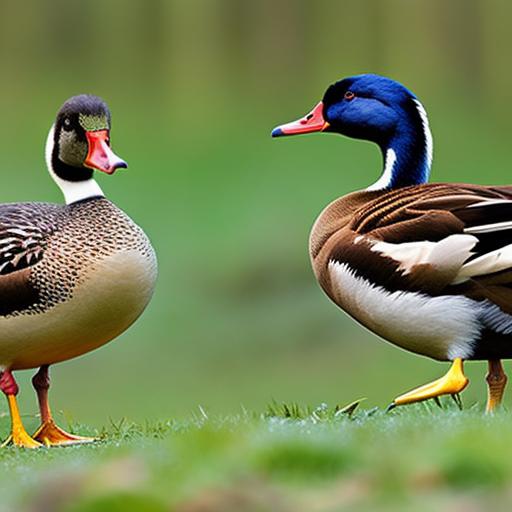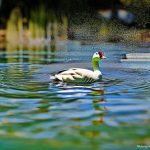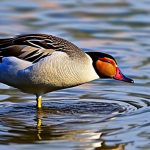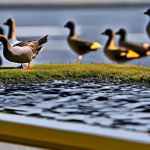Rare duck and geese breeds are a unique and fascinating group of birds that are not commonly seen in the average farm or backyard setting. These breeds are often characterized by their distinctive colors, patterns, and physical features, making them a popular choice for hobbyists and enthusiasts. Some of the most well-known rare duck breeds include the Silver Appleyard, Cayuga, and Saxony, while rare geese breeds such as the Sebastopol, Pilgrim, and Steinbacher are also highly sought after.
One of the key aspects of understanding rare duck and geese breeds is recognizing the importance of preserving these unique genetic lines. Many of these breeds are at risk of extinction due to declining numbers and lack of breeding programs. By raising and breeding rare duck and geese breeds, individuals can play a crucial role in conserving these valuable genetic resources for future generations. Additionally, understanding the specific characteristics, behaviors, and care requirements of each rare breed is essential for successful breeding and raising of these birds.
Choosing the Right Breed for Your Environment
When it comes to choosing the right rare duck and geese breed for your environment, there are several factors to consider. Climate, space, and available resources all play a significant role in determining which breed is best suited for your specific situation. For example, breeds such as the Buff Orpington duck and Toulouse goose are known for their cold-hardy nature, making them ideal choices for colder climates. On the other hand, breeds like the Indian Runner duck and African goose thrive in warmer environments.
In addition to climate considerations, the amount of space available for the birds should also be taken into account. Some rare duck and geese breeds, such as the Welsh Harlequin duck and Brecon Buff goose, are more compact and can thrive in smaller areas, while others, like the Pomeranian duck and Embden goose, require more space to roam and forage. By carefully evaluating your environment and resources, you can make an informed decision on which rare breed is the best fit for your situation.
Setting Up the Perfect Habitat for Rare Ducks and Geese
Creating the perfect habitat for rare ducks and geese is essential for their health, well-being, and overall happiness. The first step in setting up a suitable habitat is to provide adequate shelter and protection from the elements. This can be achieved through the use of well-constructed duck houses and goose shelters that offer protection from wind, rain, and extreme temperatures. Additionally, providing access to clean water for swimming and foraging is crucial for the overall health and happiness of rare duck and geese breeds.
Another important aspect of setting up the perfect habitat for rare ducks and geese is ensuring that they have access to a suitable diet and foraging opportunities. Ducks and geese are natural foragers and thrive on a diet that includes a variety of plants, insects, and small aquatic creatures. Providing access to a natural foraging area, such as a pond or wetland, can help satisfy their natural instincts and provide them with the nutrients they need to thrive. Additionally, incorporating a balanced diet of commercial feed, fresh greens, and protein sources can help ensure that rare duck and geese breeds receive the nutrition they need to stay healthy and vibrant.
Feeding and Nutrition for Rare Duck and Geese Breeds
Feeding and nutrition are critical aspects of raising rare duck and geese breeds, as these birds have specific dietary requirements that must be met to ensure their health and well-being. One of the most important considerations when it comes to feeding rare duck and geese breeds is providing a balanced diet that meets their nutritional needs. This can be achieved through the use of high-quality commercial feed that is specifically formulated for waterfowl, as well as the inclusion of fresh greens, vegetables, and protein sources such as mealworms or fish.
In addition to providing a balanced diet, it is also important to ensure that rare duck and geese breeds have access to clean, fresh water at all times. Ducks and geese are waterfowl and require access to water for drinking, bathing, and foraging. Providing a clean water source, such as a pond or shallow pool, is essential for their overall health and well-being. Additionally, ensuring that the water source is free from contaminants and pollutants is crucial for preventing illness and disease in rare duck and geese breeds.
Health and Wellness for Rare Duck and Geese Breeds
Maintaining the health and wellness of rare duck and geese breeds is a top priority for breeders and enthusiasts. These birds are susceptible to a variety of health issues, including respiratory infections, parasites, and nutritional deficiencies, so it is important to be proactive in preventing and treating these conditions. Regular health checks, vaccinations, and parasite control measures can help ensure that rare duck and geese breeds remain healthy and vibrant.
In addition to preventative measures, providing a clean and sanitary living environment is essential for the health and wellness of rare duck and geese breeds. Regular cleaning and disinfection of duck houses, goose shelters, and water sources can help prevent the spread of disease and illness. Additionally, providing access to fresh air, sunlight, and opportunities for exercise and foraging can help promote the overall well-being of rare duck and geese breeds.
Breeding and Reproduction of Rare Duck and Geese Breeds
Breeding and reproduction are important aspects of raising rare duck and geese breeds, as they play a crucial role in preserving these unique genetic lines for future generations. One of the key considerations when it comes to breeding rare duck and geese breeds is selecting high-quality breeding stock with desirable traits and characteristics. This can be achieved through careful evaluation of physical attributes, temperament, and genetic background to ensure that the offspring will exhibit the desired traits of the breed.
In addition to selecting suitable breeding stock, providing a suitable breeding environment is essential for successful reproduction of rare duck and geese breeds. This can include providing nesting boxes, brooding areas, and suitable mating opportunities for the birds. Additionally, monitoring the breeding process and providing appropriate care and nutrition for the breeding pairs can help ensure the health and success of the offspring.
Training and Handling Rare Duck and Geese Breeds
Training and handling rare duck and geese breeds is an important aspect of raising these birds, as it can help ensure their safety, well-being, and overall happiness. One of the key considerations when it comes to training and handling rare duck and geese breeds is establishing a bond of trust and respect with the birds. This can be achieved through regular interaction, positive reinforcement, and gentle handling to help the birds feel comfortable and secure in their environment.
In addition to building a bond of trust, training and handling rare duck and geese breeds also involves teaching them basic commands and behaviors that can help make daily care and management easier. This can include training the birds to come when called, to enter and exit their shelter on command, and to be comfortable with being handled and examined. By establishing a routine of positive reinforcement and consistent training, rare duck and geese breeds can become well-behaved and cooperative members of the flock.
Common Challenges and Solutions for Raising Rare Duck and Geese Breeds
Raising rare duck and geese breeds comes with its own set of challenges, but with careful planning and proactive management, these challenges can be overcome. One of the most common challenges when it comes to raising rare duck and geese breeds is predator control. Ducks and geese are natural prey for a variety of predators, including foxes, raccoons, and birds of prey, so it is important to implement effective predator control measures to protect the birds. This can include the use of secure fencing, predator-proof shelters, and the presence of guard animals such as dogs or geese.
Another common challenge when raising rare duck and geese breeds is managing their social dynamics and behavior. Ducks and geese are social animals that thrive in a flock environment, but they can also exhibit aggressive behaviors and territorial tendencies. Providing adequate space, enrichment, and opportunities for social interaction can help prevent conflicts and promote harmonious relationships within the flock. Additionally, providing a balanced diet, access to clean water, and opportunities for exercise and foraging can help prevent boredom and stress in rare duck and geese breeds.
Showing and Exhibiting Rare Duck and Geese Breeds
For many rare duck and geese breeders, the opportunity to showcase their birds at shows and exhibitions is a rewarding and exciting experience. Showing and exhibiting rare duck and geese breeds provides breeders with the opportunity to showcase their hard work and dedication, as well as to network with other enthusiasts and breeders. Additionally, participating in shows and exhibitions can help raise awareness about the importance of preserving rare genetic lines and can help promote the conservation of these valuable breeds.
One of the key aspects of showing and exhibiting rare duck and geese breeds is preparing the birds for the event. This can include grooming, training, and conditioning the birds to ensure that they are in top condition for the show. Additionally, providing appropriate housing, transportation, and care for the birds during the event is essential for their health and well-being. By participating in shows and exhibitions, breeders can help promote the value and importance of rare duck and geese breeds and can contribute to the conservation and preservation of these unique genetic lines.
Resources and Organizations for Rare Duck and Geese Breeders
For individuals interested in raising rare duck and geese breeds, there are a variety of resources and organizations available to provide support, information, and networking opportunities. One of the most valuable resources for rare duck and geese breeders is the American Poultry Association, which provides a wealth of information on breed standards, care guidelines, and breeding programs for a variety of rare and heritage breeds. Additionally, the Livestock Conservancy is a valuable resource for individuals interested in conserving rare genetic lines and promoting the preservation of rare duck and geese breeds.
In addition to national organizations, there are also a variety of regional and local clubs and associations that cater to rare duck and geese breeders. These organizations often provide opportunities for networking, education, and support, as well as access to shows, exhibitions, and breeding programs. By connecting with other enthusiasts and breeders, individuals can gain valuable knowledge and experience in raising rare duck and geese breeds and can contribute to the conservation and preservation of these valuable genetic resources.
Meet Walter, the feathered-friend fanatic of Florida! Nestled in the sunshine state, Walter struts through life with his feathered companions, clucking his way to happiness. With a coop that’s fancier than a five-star hotel, he’s the Don Juan of the chicken world. When he’s not teaching his hens to do the cha-cha, you’ll find him in a heated debate with his prized rooster, Sir Clucks-a-Lot. Walter’s poultry passion is no yolk; he’s the sunny-side-up guy you never knew you needed in your flock of friends!







